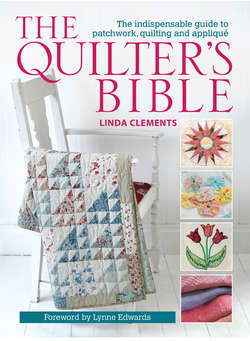Читать книгу The Quilter's Bible - Linda - Страница 24
На сайте Литреса книга снята с продажи.
The Colour Wheel
ОглавлениеThis is a tool that artists have used for centuries and is useful for quilters too. A colour wheel is a way of arranging colours so their relationships can be seen. At its simplest the colour wheel is based on twelve colours. Three of these – blue, red and yellow – are described as primary colours. These are pure colours seen when light is split and they cannot be created from other colours.
When primary colours are combined in equal amounts they create three secondary colours of violet, green and orange (blue + red = violet; blue + yellow = green; red + yellow = orange).
When primary colours are combined with secondary colours in equal amounts they create six tertiary or intermediate colours of yellow-orange, red-orange, red-violet, blue-violet, blue-green and yellow-green.
These twelve colours are the ones seen in the colour wheel diagram. Colours are also described as ‘warm’ or ‘cool’ and having a ‘value’, that is, a lightness or darkness. Colour becomes even more interesting once you start creating tints, tones and shades. A tint is a colour with white added. Tints are often called pastels and are normally soft, light and airy. A tone is a colour with grey added. Tones have a similar muted quality and can be a bit dull but act as a foil to brighter colours. A shade is a colour with black added. Shades can be rich, dark and imposing. The intensity of a colour also plays a part and highly saturated colours, such as a really brilliant red or yellow, can be too forceful and overwhelming and are best used in moderation.
Colours can be further described by their position on the colour wheel. Colours next to each other are the most similar and are described as analogous. Those colours that are opposite each other are the most different and are called complementary. Sometimes a finished quilt can seem flat and dull and this may be because it has been made with fabrics all having the same value or with too many colours with the same tone. A mixture of light, medium and dark will create more visual interest, as will a splash of a complementary colour. A value finder is a useful tool for judging the value and tone of a fabric’s colour (see Design Tools: Value finder).
